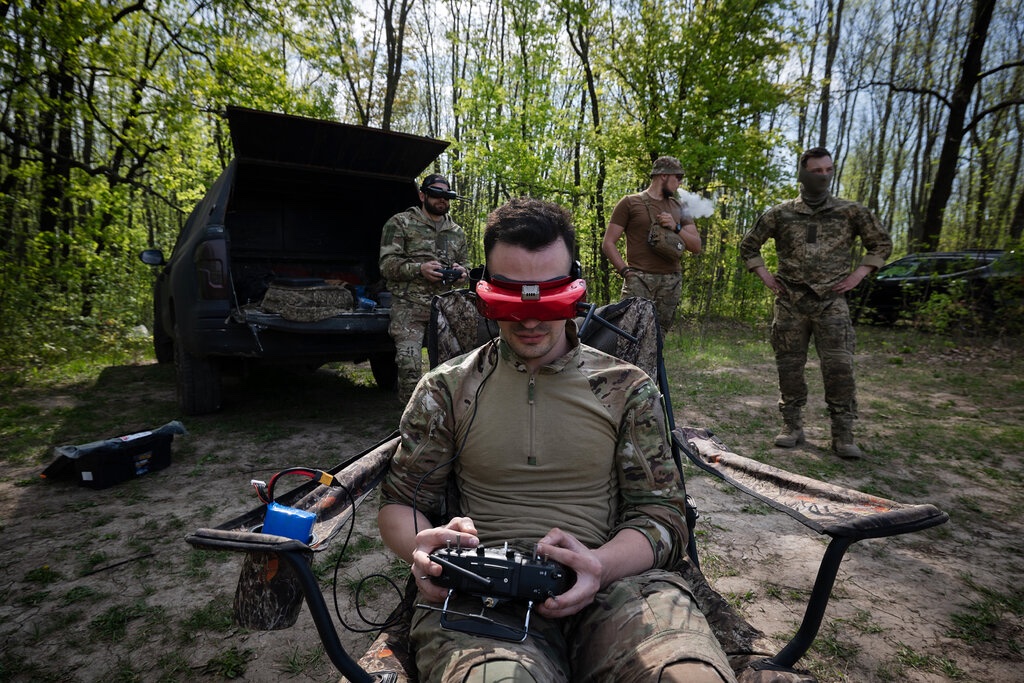After three years of war in Ukraine, military futurologists have a massive expanding archive of video stream of medium-intensity carnage to analyze. For much of the conflict, its primary characteristics have been in dispute: is it a clash of high-tech weapons systems or a throwback to WWI era attrition war? Although Russian superiority in artillery production and manpower have arguably been the decisive factors in securing what now looks like an inevitable defeat over Ukraine, the slow-moving frontline has provided a brutal laboratory for the testing of new weapons systems and jamming devices where both sides have been compelled to step up the pace of innovation. Russia can now penetrate even the best of American missile defense systems with its hypersonic missiles: the Zircon, Kinzhal, Avangard, and most recently the Oreshnik. The US and NATO, for their part, have provided the Ukrainians with extensive real-time satellite surveillance and targeting, allowing their proxy to strike with the accuracy of an American integrated command center. But it’s drone warfare that has been the source of some of the most intensive commentary and speculation. The iteration of new and improved drones, often in response to electronic warfare (EW) counter-measures, has put the spectre of autonomous weapons systems at the forefront of the minds of military planners.
The US led the way in the first generation of unmanned aerial vehicle (UAV) warfare during the interminable “War on Terror.” The Predator drone system could fly long distances and fire on high-value targets, thereby offsetting the possible US military casualties involved in deployments closer to a conflict zone. But the Predator system operates more like a pilotless fighter-jet, capable of carrying a heavy payload, but costing ~$20 million each. Cheaper drones as a handmaiden to combined arms infantry warfare first made a decisive impact in the 2020 Nagorno-Karabakh War between Armenia and Azerbaijan. Turkish supplied Bayraktar TB2 UAVs gave Azerbaijan a dynamic solution to both locating and striking Armenian armored infantry positions. By now — five years later — the Bayraktar system is obsolete. The basic rule of thumb is that the larger the drone, the more destructive the deliverable payload, but the more detectable and jammable its navigation system. Thus, there is an imperative for increasingly small and cheap drones deployed in swarms that can take out expensive targets like tanks, radar systems and weapons depots.
The evolution of drone warfare in the Ukraine War points towards the increased use of artificial intelligence (AI) for both target selection and terminal phase contact with the target. The adoption of AI in drones is itself a necessary adaptation to extensive use of EW jamming by the Russian military. Counter-drone EW works by jamming the navigational signals sent between the drones and satellite based GPS. Russian drone-evasion procedures include both high-tech and low-tech solutions. One of the more innovative tactics includes radar systems that can easily hack into a Ukrainian drone’s camera and allow Russian soldiers driving in the vicinity to know if they’re nearby and see if they’re being targeted by it. A more common, but very low-cost and “DIY” solution is to encase tanks, armored vehicles and even entire roadways in strong netting so that when a small drone engages a target, the explosive charge of the drone is far less likely to do serious damage. Many Russian soldiers have also taken to mounting fast dirt bikes in Mad Max-type cavalry charges when speeding towards Ukrainian positions.
If a drone can operate without satellite or low-earth aerial reconnaissance assets, then it becomes much less jammable. AI-powered drones can perform their functions without either human remote control or GPS communications. The US AI-complex led by Google is trying to spearhead an effort to use “modular manufacturing” dispersed in workshops throughout Ukraine to adapt the use of different parts to counter the counter-measures of the Russian military. Also, the use of “swarm communication technology” can allow even AI operated drones to react to jamming in certain areas to autonomously find pockets where EW coverage is weak. One of the more sci-fi solutions on the horizon is the use of “mother drones” (carriers of many smaller drones) that are human operated that deploy near a combat area and unleash their swarm of AI drones to detect and kill in an automated fashion.
We are steadily creeping towards an era of fully autonomous drone systems operating only according to the legal distinction of combat area vs. civilian area. Drones already operate autonomously in designated “kill zones.” Article 82 of the 1977 Additional Protocol to the Geneva Conventions requires that parties to a conflict “shall ensure that legal advisers are available, when necessary, to advise military commanders at the appropriate level on the application of the Conventions and this Protocol.” Since the 1990s, military lawyers have gradually been incorporated into the “targeting cycle.” But as AI is itself increasingly taking over once esteemed legal advice, we may soon find ourselves in high-crime areas “all watched over by machines of loving grace.”
-Carl Weaver, May 2025

